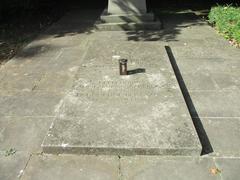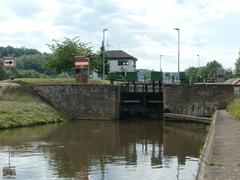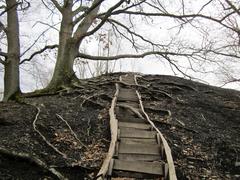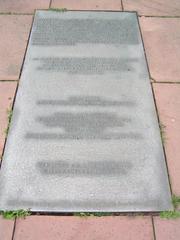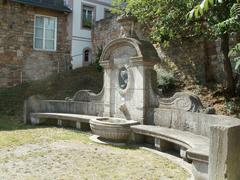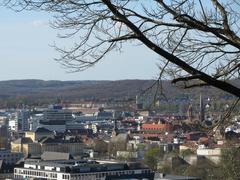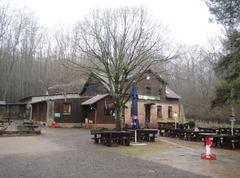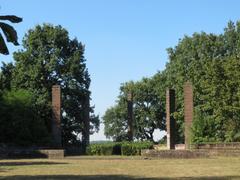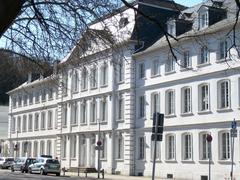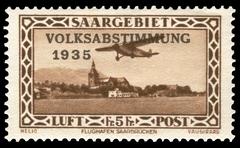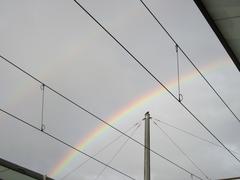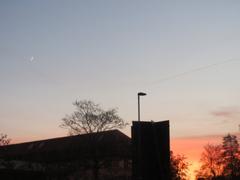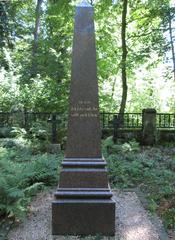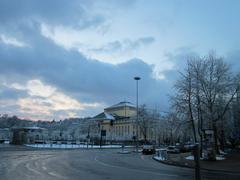40Er Grab Saarbrücken: Visiting Hours, Tickets, and Historical Site Guide
Date: 03/07/2025
Introduction
The Notkirche am 40Er Grab (Emergency Church at the 40th Grave) in Alt-Saarbrücken stands as a unique symbol of resilience, international solidarity, and post-war recovery. Originally constructed from a Swiss military barrack gifted in 1946, this modest wooden church is more than a religious building—it is a living monument to Saarbrücken’s layered history, military remembrance, and vibrant community spirit. Adjacent to the historic 40Er Grab, which commemorates soldiers from the Franco-Prussian War, the site provides a multifaceted journey through the city’s past, from prehistoric roots to contemporary cultural life (de.wikipedia.org; stiftung-kiba.de).
This comprehensive guide covers the origins and architecture of the Notkirche, practical visitor information, community events, and nearby attractions, ensuring a meaningful and memorable visit for history enthusiasts, cultural travelers, and local residents alike.
Table of Contents
- Introduction
- Origins of the Notkirche at 40Er Grab
- Architectural Features and Artistic Highlights
- Cultural and Community Significance
- Visiting the Notkirche: Practical Information
- The 40Er Grab Burial Site: Historical Background
- Facilities, Amenities, and Travel Tips
- Community Events and Annual Festivals
- Nearby Attractions and Suggested Itineraries
- Frequently Asked Questions (FAQs)
- Conclusion
- References
Origins of the Notkirche at 40Er Grab
In the wake of World War II, Saarbrücken faced the devastation of its city center and a desperate need for places of worship. The Evangelical Church in Germany, supported by the World Council of Churches and the American Lutheran Church, initiated a program to provide prefabricated emergency churches—Notkirchen—using surplus military barracks. The Notkirche at 40Er Grab, delivered in a railway wagon labeled “Liebesgaben” (gifts of love), was assembled on Spichererbergstraße and inaugurated in September 1946, quickly becoming a spiritual and social hub for the Protestant community (stiftung-kiba.de; Saarbrücker Zeitung).
Architectural Features and Artistic Highlights
Exterior
The Notkirche’s utilitarian wooden construction, rectangular floor plan, and gabled roof reflect its origins as a Swiss military barrack. The simple façade emphasizes function and resilience—a testament to the spirit of post-war reconstruction.
Adjacent to the church is the 40Er Grab, a sandstone grave marking the resting place of three soldiers from the Hohenzollern Fusilier Regiment No. 40, who fell defending Saarbrücken during the Franco-Prussian War. This grave, inscribed “Hier ruhen 3 bei der Verteidigung Saarbrückens gefallene Vierziger,” is a direct link to the city’s military past (de.wikipedia.org).
Interior
The church’s interior is characterized by exposed wooden beams and warm paneling, creating a tranquil atmosphere. The altar is adorned with wooden panels inscribed with the Beatitudes, emphasizing the church’s spiritual mission (institut-aktuelle-kunst.de).
Stained Glass Windows
In 1953, artist György Lehoczky designed four stained glass windows depicting the Evangelists, adding vibrant color and artistic distinction to the church’s understated interior.
Organ and Bells
A roof turret and organ niche were added in 1952. The original bell, cast from donated metal and blessed in 1946, was recast in 1953 at the Mabilon bell foundry, a symbol of local commitment (createsoundscape.de).
Restoration and Preservation
The Notkirche has undergone significant restoration, notably in 2006–2007, and is now a protected monument, recognized for its historical, architectural, and cultural value (stiftung-kiba.de).
Cultural and Community Significance
The Notkirche is a vibrant community center, hosting worship services, concerts, educational programs, and the annual Notkirchenfest—a festival featuring music, markets, and children’s activities (Musikschule Saarbrücken). It also served as a kindergarten in the immediate post-war period, further demonstrating its social importance (de.wikipedia.org). Its preservation is supported by organizations like Stiftung KiBa, which provided significant funding for its restoration.
Visiting the Notkirche: Practical Information
Visiting Hours
- Monday–Saturday: 9:00 AM – 6:00 PM
- Sunday: 10:00 AM – 4:00 PM (hours may vary during services or special events)
Tickets and Admission
- Admission: Free; donations are welcome to support maintenance and programming.
Accessibility
- Wheelchair accessible via ramp at the main entrance.
- Accessible restrooms available nearby.
- Parking: Limited on-site; additional spaces on Spichererbergstraße.
Guided Tours
- Offered monthly and during special events.
- Book in advance via the parish office or official tourism website (tourismus.saarbruecken.de).
Photography Tips
- Photography is permitted for personal use (no flash during services).
- The wooden interior and stained glass are especially photogenic during daylight and golden hour.
The 40Er Grab Burial Site: Historical Background
The 40Er Grab itself is a prehistoric burial mound and later a war memorial, reflecting Saarbrücken’s ancient past and its pivotal role in Franco-German history. Bilingual information panels on-site detail the grave’s origins, excavation history, and cultural symbolism (tourismus.saarbruecken.de).
Facilities, Amenities, and Travel Tips
- Information panels in German and English/French.
- Seating and rest areas in surrounding parks.
- Nearby restrooms in park facilities or adjacent attractions.
- Cafés and restaurants in the St. Johann district.
- Well-maintained paths for walking, wheelchair access, and cycling.
- Public transport: Easily accessible via buses, trams, and Saarbahn (plan routes at saarvv.de).
- Parking: Available nearby; may be limited during events.
Community Events and Annual Festivals
- Notkirchenfest: Annual festival in late September, featuring music, community markets, and family activities (wochenspiegelonline.de).
- Open Monument Day: Special guided tours and events in September (denkmalschutz.de).
- Memorial services at the 40Er Grab, especially on Volkstrauertag (National Day of Mourning).
Nearby Attractions and Suggested Itineraries
- Saarbrücker Schloss: Baroque castle with city views and museum.
- Ludwigskirche: Renowned Baroque church.
- Deutsch-Französischer Garten: Family-friendly park.
- Völklingen Ironworks: UNESCO World Heritage Site, accessible by train.
- Saarland Museum, Old Town, and St. Johanner Markt for shopping and dining (thecrazytourist.com; delveintoeurope.com).
Sample Day Plan:
- Morning: Visit Notkirche and 40Er Grab.
- Midday: Lunch in St. Johann district.
- Afternoon: Explore Saarbrücker Schloss and Ludwigskirche.
- Evening: Relax in the Deutsch-Französischer Garten or attend a cultural event.
Frequently Asked Questions (FAQs)
Q: What are the visiting hours for the Notkirche and 40Er Grab?
A: Notkirche is open Monday–Saturday 9:00 AM–6:00 PM, Sunday 10:00 AM–4:00 PM. The 40Er Grab is accessible year-round; park hours may apply.
Q: Is there an admission fee?
A: No, entry is free; donations are appreciated.
Q: Is the site accessible for wheelchairs and strollers?
A: Yes, with ramps and accessible pathways.
Q: Are guided tours available?
A: Yes, by advance booking or during special events.
Q: What community events are held at the site?
A: The annual Notkirchenfest, memorial services, heritage days, and cultural programs.
Q: Can I take photographs?
A: Yes, but avoid flash and be respectful during services.
Conclusion
The Notkirche am 40Er Grab is a testament to Saarbrücken’s resilience, community spirit, and cultural heritage. Its history as the only remaining American-donated emergency church, paired with the adjacent war memorial and prehistoric burial mound, provides a profound and multifaceted visitor experience. With free access, engaging events, and proximity to major attractions, the site is an essential stop for anyone exploring Saarbrücken.
Plan your visit, join a guided tour, and participate in community events to fully appreciate this unique landmark. For updates, event info, and audio guides, download the Audiala app and follow the Evangelical Kirchengemeinde Alt-Saarbrücken on social media.
References
- Notkirche Saarbrücken on Wikipedia
- Stiftung KiBa: Notkirche am 40er Grab Saarbrücken
- Saarbrücker Zeitung: Evangelische Gemeinde feiert Notkirchenfest
- Musikschule Saarbrücken: Kulturtagestour 2025
- Institut für aktuelle Kunst: Notkirche am 40er Grab Saarbrücken
- Denkmalschutz.de: Evangelische Notkirche Saarbrücken
- Saarbrücken Tourism: Sehenswürdigkeiten
- Wochenspiegel Online: Notkirchenfest am 40er Grab
- Createsoundscape.de: Glockenfinder - Evang. Notkirche am 40er Grab
